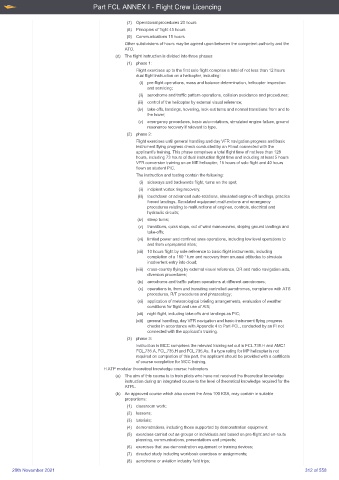Page 312 - UK Aircrew Regulations (Consolidated) 201121
P. 312
Part FCL ANNEX I - Flight Crew Licencing
(7) Operational procedures 20 hours
(8) Principles of flight 45 hours
(9) Communications 15 hours
Other subdivisions of hours may be agreed upon between the competent authority and the
ATO.
(d) The flight instruction is divided into three phases:
(1) phase 1:
Flight exercises up to the first solo flight comprise a total of not less than 12 hours
dual flight instruction on a helicopter, including:
(i) pre-flight operations, mass and balance determination, helicopter inspection
and servicing;
(ii) aerodrome and traffic pattern operations, collision avoidance and procedures;
(iii) control of the helicopter by external visual reference;
(iv) take-offs, landings, hovering, look-out turns and normal transitions from and to
the hover;
(v) emergency procedures, basic auto-rotations, simulated engine failure, ground
resonance recovery if relevant to type.
(2) phase 2:
Flight exercises until general handling and day VFR navigation progress and basic
instrument flying progress check conducted by an FI not connected with the
applicant’s training. This phase comprises a total flight time of not less than 128
hours, including 73 hours of dual instruction flight time and including at least 5 hours
VFR conversion training on an ME helicopter, 15 hours of solo flight and 40 hours
flown as student PIC.
The instruction and testing contain the following:
(i) sideways and backwards flight, turns on the spot;
(ii) incipient vortex ring recovery;
(iii) touchdown or advanced auto-rotations, simulated engine-off landings, practice
forced landings. Simulated equipment malfunctions and emergency
procedures relating to malfunctions of engines, controls, electrical and
hydraulic circuits;
(iv) steep turns;
(v) transitions, quick stops, out of wind manoeuvres, sloping ground landings and
take-offs;
(vi) limited power and confined area operations, including low level operations to
and from unprepared sites;
(vii) 10 hours flight by sole reference to basic flight instruments, including
completion of a 180 ° turn and recovery from unusual attitudes to simulate
inadvertent entry into cloud;
(viii) cross-country flying by external visual reference, DR and radio navigation aids,
diversion procedures;
(ix) aerodrome and traffic pattern operations at different aerodromes;
(x) operations to, from and transiting controlled aerodromes, compliance with ATS
procedures, R/T procedures and phraseology;
(xi) application of meteorological briefing arrangements, evaluation of weather
conditions for flight and use of AIS;
(xii) night flight, including take-offs and landings as PIC;
(xiii) general handling, day VFR navigation and basic instrument flying progress
checks in accordance with Appendix 4 to Part-FCL, conducted by an FI not
connected with the applicant’s training.
(3) phase 3:
Instruction in MCC comprises the relevant training set out in FCL.735.H and AMC1
FCL,735.A, FCL.735.H and FCL.735.As. If a type rating for MP helicopter is not
required on completion of this part, the applicant should be provided with a certificate
of course completion for MCC training.
H ATP modular theoretical knowledge course: helicopters
(a) The aim of this course is to train pilots who have not received the theoretical knowledge
instruction during an integrated course to the level of theoretical knowledge required for the
ATPL.
(b) An approved course which also covers the Area 100 KSA, may contain in suitable
proportions:
(1) classroom work;
(2) lessons;
(3) tutorials;
(4) demonstrations, including those supported by demonstration equipment;
(5) exercises carried out as groups or individuals and based on pre-flight and en-route
planning, communications, presentations and projects;
(6) exercises that use demonstration equipment or training devices;
(7) directed study including workbook exercises or assignments;
(8) aerodrome or aviation industry field trips;
20th November 2021 312 of 558

